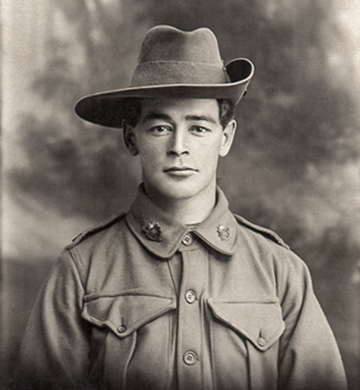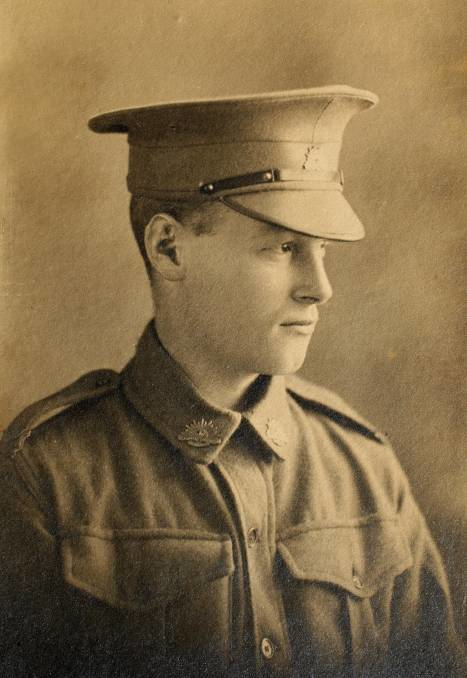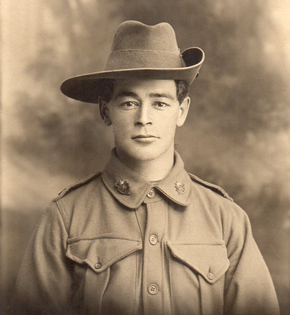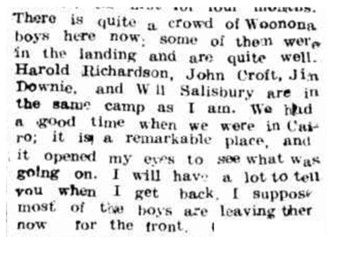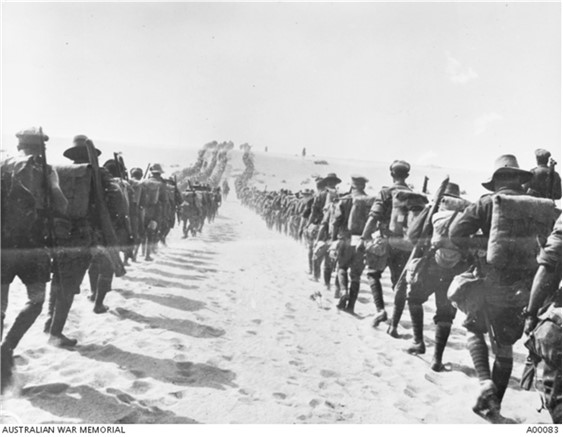Harold RICHARDSON
Eyes brown, Hair brown, Complexion fresh
Harold Richardson - Illawarra's Finest
Can you help us identify Harold?
Harold was Killed in Action at Fromelles. As part of the 54th Battalion, he was positioned near where the Germans collected soldiers who were later buried at Pheasant Wood. There is a chance he might be identified, but we need help. We are still searching for suitable family DNA donors. In 2008 a mass grave was found at Fromelles, a grave the Germans dug for 250 (Australian) bodies they recovered after the battle. See the DNA box at the end of the story for what we do know about his family.
Early Life
Harold Richardson was born on 27 December 1888 in Stockton, New South Wales, the second of Robert Melvin and Ada (nee Youll) Richardson’s six children. His siblings were Robert (Bob), Alice (Allie), Alexander Melvin (Vin), Ada Elenor (Popsie) and Edna Isabel. Harold’s grandfather, Alexander, had come to Australia in the mid-1850’s from Lanarkshire, Scotland.
Vin served in the AIF with the 45th Battalion (No. 2711), was wounded in 1918, but returned to Australia after the War. The family later moved to Popes Road, Woonona, their home was named ‘Melvin’. His mother’s family may have been in Newcastle for some generations. Harold’s father Robert ran the Woonona Universal Store.
Harold attended Stockton Public School and East Maitland High School and obviously was a good student, as he also studied electrical and mechanical engineering. He was one of the youngest in NSW to achieve a First-Class Colliery Manager's Certificate and also was certified by T.A. Southern’s School of Mining in Wales.
When Harold enlisted, he was working as a deputy in the Kembla Colliery, and as reflected in the news article below, was very well respected.
He was also a keen tennis player and had been the Treasurer of the South Coast Tennis Association.
Off to War
Harold enlisted with the AIF on 10 June 1915 at Liverpool, NSW, was originally assigned to the 9th Reinforcements of the 2nd Battalion as a Private. His initial training was at the Liverpool Camp, near Sydney.
Woonona was well represented and Harold was among his mates, as mentioned in L. W. Wilson’s letter home.
After a relatively short period of training in Australia, Harold embarked from Sydney on 30 September 1915 on board HMAT A8 Argyllshire for the month-long trip to Egypt. Shortly after his arrival, he came down with mumps and spent a month in hospital at Abbassia, Cairo, returning to duty on Christmas Eve.
As Harold was arriving, major reorganizations in the troops were underway following the heavy losses at Gallipoli and the thousands of new recruits streaming in from Australia. In mid-February 1916 the 54th Battalion was formed at Tel-el-Kebir and Harold was assigned to this new unit on 14 February, with training of the old and new hands continuing. Harold’s personal capabilities were noticed, he was promoted to Corporal on 1 March and then to Sergeant on 1 May.
By the end of March, much of the basic training in musketry and bayonet use had been completed for all the new soldiers and they were sent to Ferry Post, on foot, a trip of about 60 km that took three days. It was a significant challenge, walking over the soft sand in the 38°C heat with each man carrying their own possessions and 120 rounds of ammunition.
After arriving at the Ferry Post Camp they were rewarded with being able to have a swim in the Canal.
The troops spent all of May at the front line trenches in Katoomba Heights, 8 miles from the Suez Canal. During their march, H. R. H. the Prince of Wales visited the troops and they greeted him with “enthusiastic cheers”.
Source AWM4 23/71/2, 54th Battalion War Diaries, March 1916, page 13
Fromelles
The call to the Western Front to join with the British Expeditionary Force came on 20 June and the 982 soldiers of the 54th Battalion left Egypt. They sailed on the Caledonian for the 10 day trip to Marseilles via Malta. After disembarking in France there was a three-day train trip to Hazebrouck, 30 km west of Fleurbaix.
By July the Battalion was billeted in barns, stables and private houses in nearby Thiennes for a week. Training now included the use of gas masks and exposure to the effects of the artillery shelling. It was hoped that these tests would “inspire the men with great confidence”.
Source AWM4 23/71/6 54th Bn War Diaries July 1916 page 2
On 10 July they moved to Sailly sur la Lys and on the 11th Harold was into the trenches for the first time. The health and spirit of the troops at that time was reported as good.

After a few days getting exposed to the trenches, they moved back to billets in Bac-St-Maur. Major Roy Harrison wrote home on July 15th. With his Gallipoli experience, the tone in this letter was certainly circumspect for the upcoming battle:
“The men don’t know yet what is before them, but some suspect that there is something in the wind. It is a most pitiful thing to see them all, going about, happy and ignorant of the fact, that a matter of hours will see many of them dead; but as the French say ‘C’est la guerre’.”
An attack was planned on the 17th, but it was delayed due to the weather. The weather soon improved and by 2.00 PM on 19 July Harold was back in the trenches, ready for the Germans. The main objective for the 54th was to take the trenches to the left of a heavily armed, elevated German defensive position, the ‘Sugar Loaf’, which dominated the front lines. If the Sugar Loaf could not be taken, the 54th and the other battalions would be subjected to murderous enfiladed fire from the machine guns and counterattacks from that direction.
As they advanced, they were to link up with the 31st and 53rd Battalions. They began to leave their trenches at 5.50 PM, moving forward in four waves – half of A & B Companies in each of the first two waves and half of C & D in the third and fourth. The first waves did not immediately charge the German lines; they went out into No-Man’s-Land and lay down, waiting for the British bombardment to lift.
At 6.00 PM, the German lines were rushed. The 54th were under heavy artillery, machine gun and rifle fire, but were able to advance rapidly. The 14th Brigade War Diary notes that the artillery had been successful and ‘very few living Germans were found in the first and second line trenches’.
Source AWM4 23/14/4, 14th Brigade War Diary July 1916 page 100
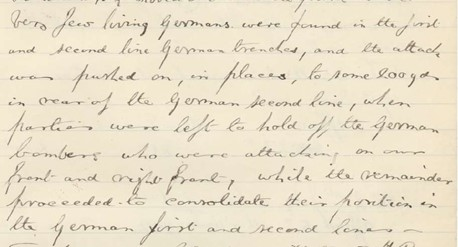
Some of the advanced trenches were just water filled ditches which needed to be fortified to be able to hold their advanced position against future attacks. There was heavy artillery, machine gun and rifle fire, but they were able to advance and link up with the 53rd on their right and, with the 31st and 32nd, occupying a line from Rouges Bancs to near Delangre Farm.
However, the 60th on their far right had been unable to advance due to the devastation from the machine gun emplacement at the Sugar Loaf, which left their right flank exposed. As the battle raged on, reinforcements and supplies were key needs for support the fighting, but Lieutenant Harris also noted the importance of ‘creature comforts’ for morale.
They held their lines through the night. However, with heavy losses and the German counterattacks, the Australians were eventually forced to retreat. This was complicated by the fact that the exposed right flank of the 54th had allowed the Germans access to the first line trench BEHIND the 54th/53rd and the German advances in the rear trenches had to repelled as they retreated.
By 7.30 AM on the 20th the 54th were pulled all the way back to Bac-St-Maur, 5 km from the front. In this very short period of time, of the 982 soldiers of the 54th that left Egypt, initial roll call counts were 73 killed, 288 wounded and 173 missing. Harold was among the missing.
To get some perspective of the battle, when Charles Bean, Australia’s official war historian, attended the battlefield two and half years later, he observed a large amount of bones, torn uniforms and Australian kit still on the battlefield.
Ultimately, 172 soldiers from the 54th were killed in action or died from their wounds. Of this, 102 were missing.
After the Battle
Unfortunately, there are no records of what happened to Harold during the battle, he was ‘just missing’. He was officially recorded as having been Killed in Action by an Enquiry in the Field held on 21 July 1916. Given that many of the missing soldiers did not have such decisions taken until mid-1917, there must have been some supporting information available to support the Enquiry’s early decision, but we will never know.
The only record in Harold’s files was that his paybook was found in the German War Offices’ records in late 1919, following Captain Mills’ Post-War extensive search for missing soldiers. This meant that Harold would have been in the advanced area of the battle and that the Germans may have recovered his body.
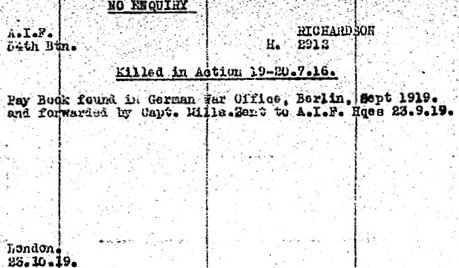
There is also a ‘curious’, undated, handwritten note in his file about him being buried, with some general map coordinates in the area of the battle.
The exact source of this is unknown, but a number of other soldiers have similar designations and some of them have been among the soldiers who have been found to be buried at the Pheasant Wood gravesite.
Back Home
News of Harold’s death travelled quickly. As reported in the Wollongong Mercury on 18 August:
“The greatest shock of all to the people of Kembla came when the news of the death of Lance Corporal Harold Richardson came to hand.”
“Great sympathy is felt for the bereaved parents and relatives of the brave young hero who sacrificed his life for King and Country.”
His family notice was simple, but very touching:
“RICHARDSON.— In fond and loving memory of Lance-Sergeant Harold Richardson, of Woonona (late of Stockton), killed in France, 19th July, aged 27 years.
Inserted by his sorrowing parents and brothers and sisters.”
Harold was awarded the 1914-15 Star, the British War medal, the Victory medal and a Memorial Scroll and a Memorial Plaque.
In an article in the Illarwara Mercury in 2009 a family member wrote:
“On travelling through France (in 2007), I pondered on where my uncle had been buried and it will be great if his remains can be found"
Harold is commemorated at:
- VC Corner Australian Military Cemetery, Fromelles - Panel 9,
- the Australian War Memorial Canberra,
- the Bulli Great War Memorial,
- the Bulli Roll of Honour and the Bulli-Woonona War Memorial.
Could Harold Still Be Found?
As discussed above, Harold was in the battle near where the Germans collected 250 soldiers who were later buried at Pheasant Wood. As of April 2024, 180 of these soldiers have been able to be identified and given proper recognition from DNA testing from family donors, including 28 of the 102 missing soldiers from the 54th Battalion. Harold may be one of those yet unidentified, Family members have come forward to donate DNA.
Family connections are sought for the following soldier
| Soldier | Harold Richardson (1888-1916 KIA Fromelles) |
| Parents Robert Melvin Richardson (1864-1946)b Springdallah VIC, d Killara NSW and Ada Youll 1865-1940) b Minmi/Newcastle, NSW d Epping, NSW |
| Siblings | Robert (1887-1958) b Stockton NSW, d Ashfield NSW, m Anne ‘Nance’ Evans | ||
| Alice (Allie) (1890-1981), m Henry Reid | |||
| Alexander Melvin (Vin) (1893-1963), d South Africa, m Annie Rigby | |||
| Ada Elenor (Popsie) (1895-1960) | |||
| Edna Isabel (1898-1972) b Stockton NSW, d Sydney NSW, m George McDowell (1898-1972) |
| Grandparents | |||
| Paternal | Alexander Melvin Richardson (1841-1920) b Lanarkshire, Scotland, d Bulli NSW and Catherine Ann Smith (1841-1918) d Bulli NSW | ||
| Maternal | Richard Youll (1825-1903) and Alice Mary Martin (1826-1867) d Newcastle NSW) |
Seeking DNA Donors

Contacts
(Contact: carla@fromelles.info or geoffrey@fromelles.info).
(Contact: army.uwc@defence.gov.au or phone 1800 019 090).
Donations
If you are able, please contribute to the upkeep of this resource.
(Contact: bill@fromelles.info ).
